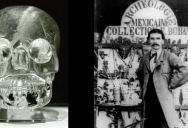Are The Crystal Aztec Skulls Real? The Jury Is In.
Everyone knows about them (thanks in no small part to Indiana Jones), and some of them are even on display in prestigious museum collections, but the truth is that no one knows whether or not they were ever authentic to begin with.
The skulls are supposedly pre-Columbian relics from Mesoamerica, but there are more than a few theories that suggest they could be nothing more than cheap knockoffs sold by a conman in the nineteenth-century.

Image Credit: Creative Commons
There are about a dozen of the skulls in public and private collections around the world. The smaller ones are only a couple of inches high, while the biggest is around the size of a bowling ball.
The British Museum purchased the first one in 1856 and claimed it was crafted by Aztecs, even though the item’s provenance was unclear.
They purchased a second one in 1897, which is still on display today, and the museum admits its origins are “most uncertain.”
“Attempts to verify that the skull is pre-Columbian on technical grounds have not proved successful.”
Other skulls have resided in Mexico’s National Museum of Anthropology and the Smithsonian Institute, though the latter was proved to be a fake in the 1950s. Mineralogist William Foshag noticed it had been created using modern jewelry-making tools.
Historians verify that skulls do feature prominently in Aztec iconography, often found carved into temples or other sacred surfaces. No crystal skulls have been documented as found at any archaeological digs, however, and none of the ones we have can be traced back to one, either.

Photo Credit: Mexican Lore
Most skulls that have been recovered are carved from basalt rather than crystal, and are quite different in appearance as well.
By the year 2000, most archaeologists believed the crystal skulls were fakes, and by 2008, hard proof showed up in the form of another crystal skull. It was mailed to the Smithsonian with a note that claimed that it had belonged to the Mexican dictator Porfirio Diaz.
Anthropologist Jane MacLaren Walsh teamed up with Margaret Sax from the British Museum to analyze it and another specimen and found that both skulls were carved with rotary wheels.

Photo Credit: Mexican Lore
The one at the Smithsonian had even been finished with a synthetic abrasive called carborundum, which didn’t exist in Aztec times.
Their analysis also verified that the skulls were likely produced somewhere like Brazil or Madagascar, not in Central America at all.
Where do the skulls come from? Some believe they’re the brain child of French conman Eugene Boban, who displayed two of them at the Exposition Universelle in Paris after working as the official archaeologist of the Mexican court of Maximilian.

Image Credit: Public Domain
Boban was not a professional archaeologist, however, and likely saw the public fascination with Aztec artifacts growing and came up with the idea to sell the skulls.
I think he would be pretty pleased to know that they had made their way all the way to Hollywood, even after the scientific community had reluctantly admitted they’re fake.
Don’t you?

Sign up to get our BEST stories of the week straight to your inbox.




